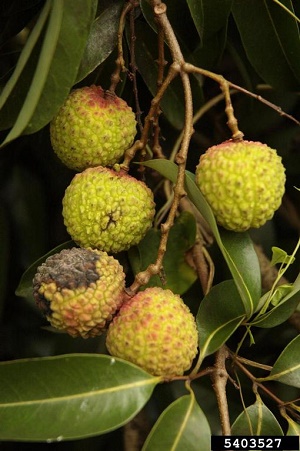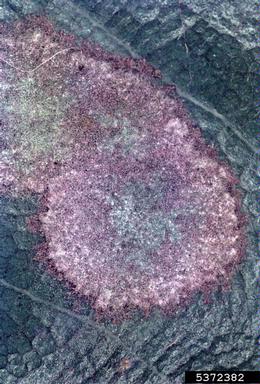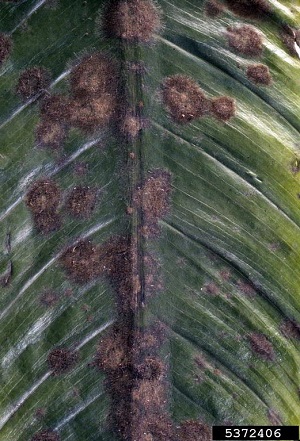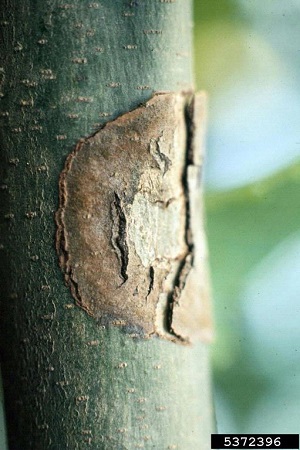| Lychee and Longan Diseases | ||||||
|---|---|---|---|---|---|---|
 Fig. 1  Bitter rot and anthracnose, Colletotrichum gloeosporioides (Penz.) Penz. and Sacc.  Fig. 2 Algal spot lesion  Fig. 5  Green-orange algal spots or "green scruf" on leaf surface. The grayish-white and darker "crusts" are lichens of the genus Strigula resulting from fungal colonization of the alga.
|
Anthracnose
(Colletotrichum
gloeosporioides)
is the major disease attacking fruit. The fruit of some cultivars
(e.g., 'Mauritius') are much more susceptible than others (e.g.,
'Brewster'). Occasionally, mushroom root rot (Clitocybe tabescens)
kills lychee trees, often in land where oaks (Quercus virginiana)
were previously grown. A parasitic lichen may occasionally attack
leaves. Red algae may attack lychee shoots and limbs; symptoms include
grayish to rust-colored, irregularly-shaped patches on the bark and
bark splitting. For more information and control measures, consult your
local UF/IFAS Extension agricultural agent. 1 Anthracnose (Fig.1) Colletotrichum gloeosporioides Anthracnose attacks both leaves and fruit of the lychee tree. However, fruit of the lychee variety 'Mauritius' is more susceptible to anthracnose than is the fruit of the 'Brewster' variety. The lychee fruit is susceptible to anthracnose infection from blossom until the fruit is half-grown. Most of the decay on mature lychee fruit is from latent infection when the fruit is small. The small spots coalesce into large brown spots as the fruit ripens. A white mycelial mat grows over the fruit during storage. 2 Update on Anthracnose Disease Control, University of Florida ext. link Stem Canker Caused by Botryosphaeria sp. This fungus is normally found attacking the terminal branches of the lychee tree. Signs of infection include sunken, shrinking, oval to irregular lesions, which may crack and expose wood. The fungus is managed by pruning out infected branches and limbs. 2 Pink Limb Blight Caused by Erythricium salmonicolor This pathogen attacks the limbs and trunk of the lychee tree. The fungus grows above and below the bark. The outer layer appears light pink to white. The fungus encircles the plant part and girdles the vascular tissue, causing foliage wilt and death. This fungus is also managed by pruning exposed wood. 2 Algal Spot Caused by Cephaleuros virescens Algal spot has a wide host range among tropical trees, including both lychee and longan trees. Lesions on leaves are roughly circular, raised, and greenish-gray in color. The alga will eventually produce rust-colored, microscopic 'spores' on the surface of the leaf spots, giving the spots a reddish appearance. The alga may also spread to branches. If branch splitting occurs, the branches may become girdled and die. Algal spot seems to flourish in groves that are treated with organic fungicides, rather than with copper-based compounds. 2
Reading Material Cephaleuros Species, the Plant-Parasitic Green Algae, University of Hawai'i at Mānoa pdf Parasitic Lichen (Fig.5) Strigula sp. Parasitic lichen may parasitize leaves on the longan. Symptoms include white star-shaped spots on leaf surfaces. This lichen colonizes leaves reducing their ability to photosynthesize. Please contact your local County Cooperative Extension Service for current control recommendations. |
|||||
| Bibliography 1 Crane, Jonathan H., et al. "Lychee Growing in the Florida Home Landscape." Horticultural Sciences Department, University of Florida, IFAS Extension. HS-6, Original Pub. Oct. 1968, Revised Feb. 1998, Feb. 2005, Oct. 2008, Oct. 2013 and Nov. 2016, Reviewed Dec. 2019, edis.ifas.ufl.edu/mg051. Accessed 21 Feb. 2017, 9 May 2020. 2 Mossler, Mark. "Florida Crop/Pest Management Profile: Lychee and Longan." edis.ifas.ufl.edu. This document is CIR1400, one of a series of the Horticultural Sciences Department, Florida Cooperative Extension Service, Institute of Food and Agricultural Sciences, University of Florida. Publication date Mar. 2002. Revised in June of 2009. Reviewed June 2012. (Archived). Accessed 23 Mar. 2015. Photographs Fig. 1 Shen, Yuan-Min. Bitter rot and anthracnose, Colletotrichum gloeosporioides (Penz.) Penz. & Sacc. 2009. Taichung District Agricultural Research and Extension Station. bugwood.org. (CC BY-NC 3.0 US). Accessed 26 Mar. 2015. Fig. 2,3 Green alga (Cephaleuros virescens ) Symptoms, Green Alga Cephaleuros virescens Kunze on Southern Magnolia. 2008. Florida Division of Plant Industry Archive, Florida Department of Agriculture and Consumer Services. bugwood.org. (CC BY-NC 3.0 US). Accessed 26 Mar. 2015. Fig. 4 Barnard, Edward L. Lichen Strigula on Southern Magnolia. 2001. Florida Department of Agriculture and Consumer Services. bugwood.org. (CC BY 3.0 US). Updated 2009. Accessed 26 Mar. 2015. Published 26 Mar. 2015 LR. Last update 9 May 2020 LR |
||||||

